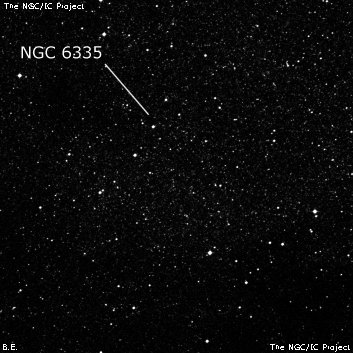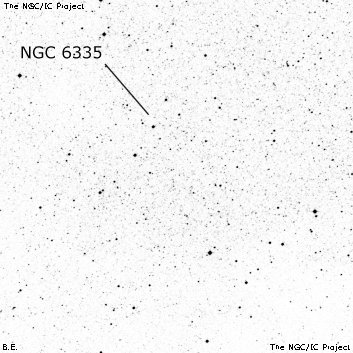NGC/IC Project Restoration Effort
(This is a very very beta version)
NGC6335


Basic Information
Location and Magnitude
Right Ascension: 17:19:31.8
Declination: -30:9:49
Constellation: SCO
Visual Magnitude:
Historic Information
Discoverer: Herschel J.
Year of discovery: 1837
Discovery aperture: 18.3
Observational
Summary description: Dif neb in patches
Sub-type: *Grp
Corwin's Notes
=====
NGC 6335. JH says of this, "The whole lower end of the zone is strongly
affected with nebulous patches," and gives only an approximate position for
it. Though included in Cederblad's catalogue of bright diffuse nebulae, there
is no bright nebulosity in the area. Instead, the Southern Sky Survey films
show a patchy field of star clouds, defined by the dust of dark nebulae. It
is apparently these star clouds that JH saw in the spring of 1837, giving him
the impression of patchy nebulosity all through his field. (Three years
earlier, he happened on the same field, giving a position then about 5 minutes
east; this has become NGC 6360, which see.)
I've adopted the approximate center of the brightest patch of stars nearest
JH's position as the position for NGC 6335. This is about a minute west of
his place which lands in a relatively poor field -- in other words, in the
midst of a dust cloud.
Steve Gottlieb offers this recent observation of my estimated position:
24" (7/7/13): at 125x this Milky Way field (roughly 15') includes a mix of
faint and moderately bright stars overlaying a bright Milky Way background
glow. Includes a 6' string oriented NW to SE of mag 11-12 stars as well as
a group of a half-dozen stars mag 9.5-12 stars (brightest is HD 156543)
about 9' SW. Only some faint stars are visible between these groups over
the glowing background, so it is not eye-catching. South of this group the
background glow dims due to dust clouds.
Steve's observation matches perfectly the 0.5 degree field I see in the DSSR2
image centered at 17 16 20, -30 06.8 (B1950.0; compare to JH's approximate
position of 17 17 36, -30 06.1, and the NGC position 17 17 21, -30 05.9, also
marked +-; both precessed to B1950.0).
Finally, note, too, that JH claims his position in CGH is four degrees too far
south; he corrects this on the first unnumbered errata page at the end of the
CGH monograph. The correct position is in GC and NGC. JH's characterization
of "The whole lower end of the zone ..." may be relevant here. Why does he
call it the "lower end"? My guess is that, given Feldhausen's latitude of
33d 59m south and NGC 6335's declination of -30d 06m, the 4-degree wide sweep
would have stretched from the zenith northwards, with its "lower end" toward
the northern horizon. This may have contributed to the confusion about the
correct north polar distance.
Unfortunately, most of the observation, number 21 in the sweep, as reproduced
in the Herschel Archive is too faint to read and illegible. A few words can
be made out, but most can not. However, the reduced position is clearly
entered as "17 09 41 +- 119 58" with the "119 58" being very dark and clearly
written over another number that is consistent with "123". These are the
numbers in CGH, so "119" is the apparently the correct degrees of NPD.
Just to be sure that there is nothing obvious at JH's orginal CGH position, I
checked that, too, on the DSSR2 and DSSI2 images -- the dominant objects
around that position are dust clouds, and the background light of the Milky
Way is much dimmer than at the corrected position. I do not think it is a
field that would cause much comment, let alone warrant an entry in JH's
observing log.
Steve's Notes
=====
NGC 6335
24" (7/7/13): at 125x this Milky Way field (roughly 15') includes a mix of faint and moderately bright stars overlaying a bright Milky Way background glow. Includes a 6' string, oriented NW to SE, of mag 11-12 stars as well as a group of a half-dozen stars mag 9.5-12 stars (brightest is HD 156543) about 9' SW. Only some faint stars are visible between these groups over the glowing background, so it is not eye-catching. South of this group the background glow dims due to dust clouds.



